|

Introduction
The Asus ProArt (PA) series is primarily aimed at
professional users and those doing colour critical work on their monitors.
However, Asus have done a good job keeping the retail costs reasonable, and so
the PA screens often provide a nice balance between performance and price. The
PA248Q is a 24" standard gamut screen providing an alternative to models like
Dell's U2412M and HP's ZR2440w. Asus do have wide gamut models available too (PA249Q) but the the
PA248Q is aimed at those who don't want or need wide gamut support, and
mainstream users who are interested in colour accuracy, but don't want the
complications of wide gamut to contend with. The 16:10 aspect ratio and 1920 x 1200
resolution are provided by an IPS panel, offering the all-round performance
we've come to expect from that technology. From a colour point of view the
screen comes factory calibrated to ensure high levels of accuracy.
The "J"
edition of the screen (PA248QJ) is the same, except that it also comes with a
calibration system - a Spyder4 Express colorimeter and software, along with a
monitor hood. This bundle provides users with an even higher level of control
and accuracy where needed. We have the PA248QJ package with us for review, but
the screen remains identical to the PA248Q so really this review can cover both
versions available.

|
Check Pricing and Buy - Direct Links
|
|
Amazon USA |
Amazon UK |
Amazon GER |
Amazon CAN
|
|
TFTCentral is a participant
in the Amazon Services LLC Associates Programme, an affiliate
advertising programme designed to provide a means for sites to earn
advertising fees by advertising and linking to Amazon.com, Amazon.co.uk,
Amazon.de, Amazon.ca and other Amazon stores worldwide. We also
participate in a similar scheme for Overclockers.co.uk. |

Specifications and Features
The following table gives detailed information
about the specs of the screen:
|
Monitor
Specifications |
|
Size |
24"WS |
Panel Coating |
Anti-glare (matte) |
|
Aspect Ratio |
16:10 |
Interfaces |
1x DVI (HDCP), 1x HDMI, 1x D-sub, 1x
DisplayPort |
|
Resolution |
1920 x 1200 |
|
Pixel Pitch |
0.270 mm |
Design
colour |
Matte black bezel, stand and base. Red trim to
screen |
|
Response Time |
6ms G2G |
Ergonomics |
-5
/ 20° Tilt, height, swivel and rotate adjustments |
|
Static Contrast Ratio |
1000:1 |
|
Dynamic Contrast Ratio |
80 million:1 |
VESA Compatible |
Yes 100mm |
|
Brightness |
300 |
Accessories |
DVI cable, DisplayPort cable, VGA cable, Power cord, USB 3.0 cable
PA248QJ
also: monitor hood, Spyder4 Express calibration kit, cable tie |
|
Viewing Angles |
178 / 178 |
|
Panel Technology |
e-IPS |
Weight (net) |
6.4Kg |
|
Backlight Technology |
W-LED |
Physical Dimensions |
(WxHxD with stand)
557.2 x 416.3 x 235 mm |
|
Colour Depth |
16.7m (6-bit + AFRC) |
|
Refresh Rate |
60Hz |
Special
Features |
Factory calibration + report, 4x USB 3.0 ports, headphone jack, PiP and PbP.
Calibration kit and hood (PA248QJ only) |
|
Colour Gamut |
Standard gamut
~72% NTSC, 100% sRGB |
The Asus PA248QJ offers a
decent set of connectivity options. There are HDMI, DVI, DisplayPort and D-sub (VGA) provided for video interfaces. It's nice to see HDMI provided for
users who want to connect other devices, particularly external Blu-ray and DVD
players, along with games consoles. The digital interfaces are HDCP certified for encrypted content as
well.
There is also an audio out connection for
connecting headphones if you wish to take the sound from the HDMI input but no
integrated speakers on this model. There are also 4x USB 3.0 ports on the screen
which are useful and it's nice to see the latest generation of USB used here.
Below is a summary of the features and connections
of the screen:
|
Feature |
Yes / No |
Feature |
Yes / No |
|
Tilt adjust |
 |
DVI |
 |
|
Height adjust |
 |
HDMI |
 |
|
Swivel adjust |
 |
D-sub |
 |
|
Rotate adjust |
 |
DisplayPort |
 |
|
VESA compliant |
 |
Component |
 |
|
USB Ports |
 |
Composite |
 |
|
Card Reader |
 |
Audio connection |
 |
|
Ambient Light Sensor |
 |
HDCP Support |
 |
|
Touch Screen |
 |
MHL Support |
 |
|
Hardware calibration |
 |
Integrated Speakers |
 |
|
Uniformity correction |
 |
PiP / PbP |
 |

Design and Ergonomics

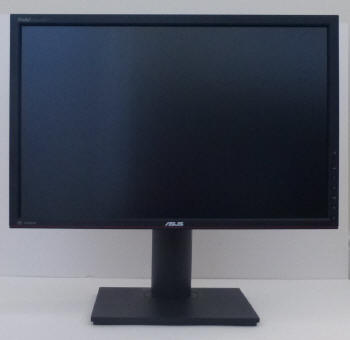
Above: front
views of the screen. Click for larger versions.
The screen comes in an all-black design with
matte plastics used for the bezel, stand and base. The bezel is nice and
thin and measures ~18mm along all sides. In the top left hand corner, in a
light grey font is a "ProArt" logo and in the bottom left hand corner is
an HDMI logo. In the middle of the lower bezel is a shiny silver Asus logo
as well. There is a thin red trim along the bottom bezel, as you can see
from the above images.


Above: front views of the screen with added hood and calibration kit. Click for larger versions
The PA248QJ version of the screen is
packaged with a removable hood and Spyder4 Express calibration kit, and is
pictured above. Apart from that, the screen is the same as the PA248Q.


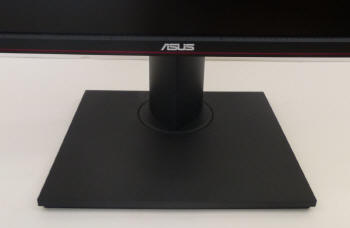
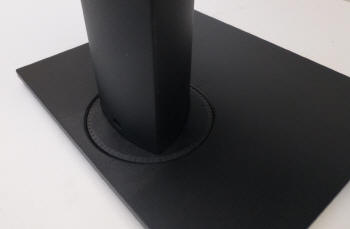
Above: views of
the base of the stand. Click for larger versions.
The stand and base is made of matte black
plastics and is rectangular in shape. It measures 235 x 280mm and provides
a sturdy base for the screen as it sits on the desk. The stand rotates
within the base when you move it side to side. The screen stays nice and
steady on the desk and does not wobble.

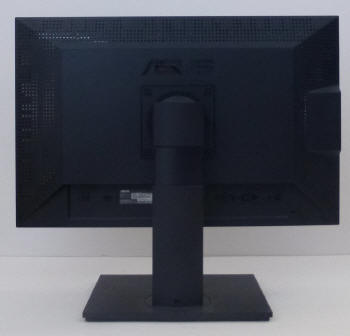
Above: rear
views of the screen. Click for larger versions.
The back of the screen is again matte black
plastic. There is an Asus logo on the back, and the stand attaches in the
middle, using a VESA 100 compliant attachment. You can remove the stand if
you wish to wall or arm mount the screen.
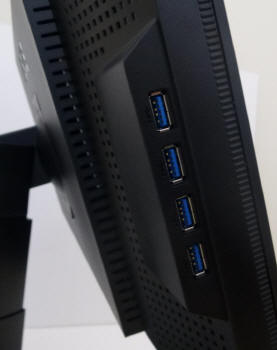
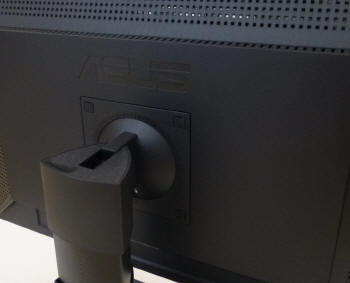
Above: Side USB
3.0 ports and back of the screen VESA connection. Click for larger
versions
The left hand edge of the screen (as viewed
from the front) has 4x USB 3.0 ports for easy access which is a nice
extra.
 
The screen offers a full range of ergonomic
adjustments from the stand which is nice to see.
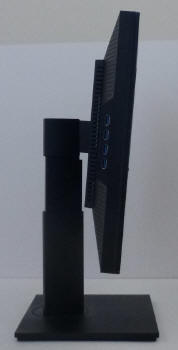
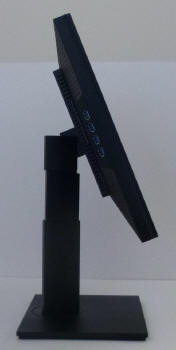
Above: full
range of tilt adjustment shown. Click for larger versions.
The tilt adjustment affords you a good range
of angles, and is smooth and easy to use. The full range of this adjustment is
shown in the images above.
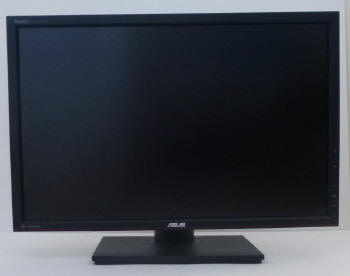
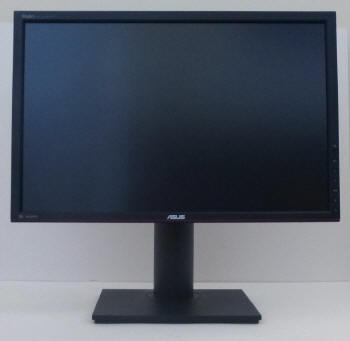
Above: Full
range of height adjustment shown. Click for larger versions.
The height adjustment provides you a 100mm
adjustment range to play with. At the lowest level, the bottom edge of the
screen is 60mm from the top of the desk, and at maximum extension the bottom
edge is 160mm from the desk. The movement is smooth but a little stiff to use,
especially when lowering it.
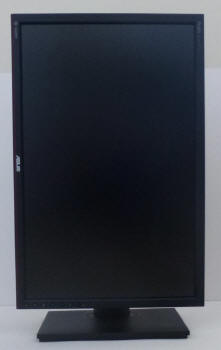
Above: rotated
view. Click for larger version
The side to side pivot adjustment is smooth
and easy to use allowing you to angle the screen for different viewing
positions easily. There is also a full rotate adjustment to switch between
portrait and landscape modes, which is smooth but a little stiff to use.
A summary of the screens ergonomic adjustments
is shown below:
|
Function |
Range |
Smoothness |
Ease of Use |
|
Tilt |
Yes |
Smooth |
Easy |
|
Height |
100mm |
Smooth |
Little stiff |
|
Swivel |
Yes |
Smooth |
Easy |
|
Rotate |
Yes |
Smooth |
Little stiff |
|
Overall |
Good range of adjustments and all pretty
easy to use, offering smooth movements |
The screen materials and build are of a good quality and
the design is nice in our opinion. There is a no audible noise from the screen
during normal use even if you listen closely or use specific test images with
a large concentration of text. The screen also stays nice and cool thanks to
the W-LED backlight unit.


Above:
interface and power connections on the back of the screen. Click for larger
versions
The back of the screen has connections for
DisplayPort, HDMI, DVI, VGA, audio output and USB upstream. On the other side
is the normal power connection (kettle lead type) and an on/off switch. The
screen has an integrated power supply so you only need to use the provided
cable, and no external power bricks.

OSD Menu


Above: views of
OSD operational buttons. Click for larger version
The OSD is accessed through a series of buttons
on the bottom right hand edge of the front bezel as shown above. As well as
the normal buttons, there is also a small 5-way navigation stick/button which allows
for quick and easy scrolling through the available settings and is intuitive
and easy to use.
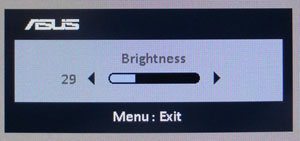
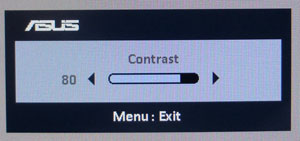
There is quick launch access from the '1' button
to the brightness control, and from the '2' button for the contrast control as
shown above. You can actually change the function of these quick access
buttons from within the main OSD menu if you wish.
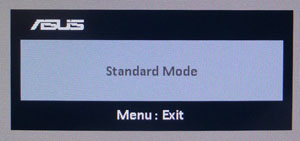

There is also quick access to switch between the
preset modes of the screen with the options above available.
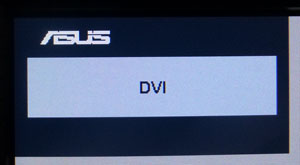
There is also an input selection button which
quickly and easily cycles through the inputs of the monitor, flashing a small
label in the top left hand corner of the screen briefly as you cycle through
the options and confirming your current input selection.
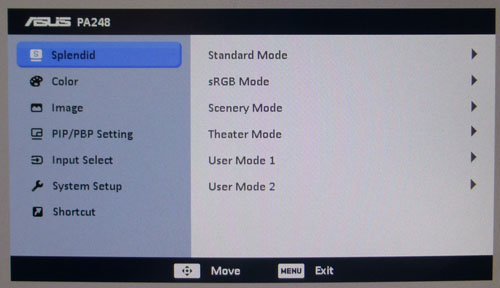
The main OSD menu is split into 7 sections shown
down the left hand side. As you scroll up and down to select a section, the
options available are shown on the right hand side. Once you enter a section,
you can then change the settings shown. The first section is the 'Splendid'
preset mode menu with the options shown above available.
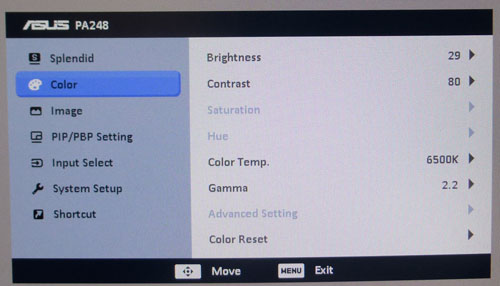
The 'Color' section provides options for
brightness, contrast and various aspects of the colour and image controls.
Here there are options to select the colour temperature and gamma as well and
in certain presets you can gain access to the RGB channels for calibration.
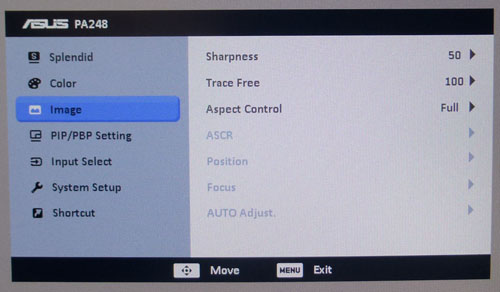
The 'image' section has a few of the advanced
features available, including the 'Trace Free' setting for
response time
control, the aspect ratio control (options for full, 1:1 and 4:3) and the
ASCR
dynamic contrast ratio control.
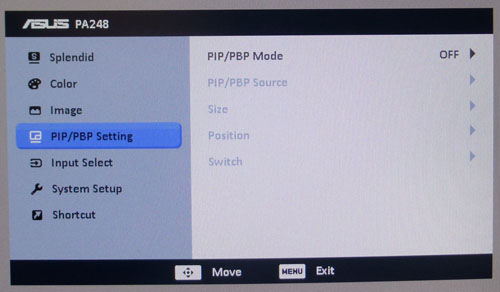
There is a PiP and PbP function available on
this screen and the above section of the OSD lets you control the settings
related to that.
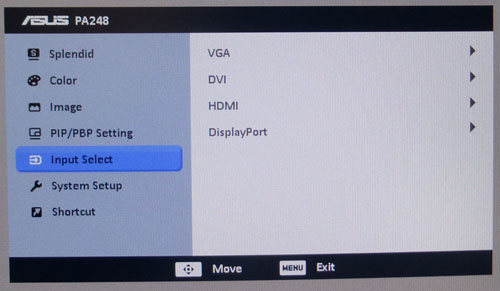
The 'input select' section allows you to switch
between the various video inputs.
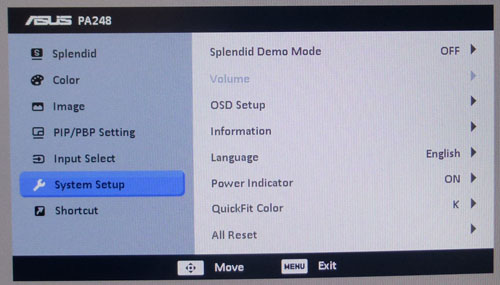
The 'system setup' section gives you control
over various aspects of the OSD itself. You can also turn the power LED off if
you want here.
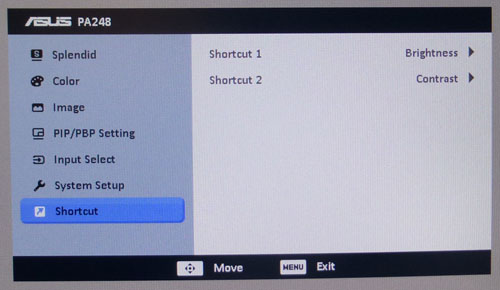
The final section allows you to change the
function of the '1' and '2' shortcut keys if you like, to something you might
use commonly.
All in all the OSD menu had a good range of
options with plenty to control. The navigation was quick and easy, and the
small control stick made it all very easy and intuitive to use.

Power Consumption
|
 |
|
State and Brightness
Setting |
Manufacturer Spec (W) |
Measured Power Usage
(W) |
|
Factory Default (50%) |
<45W |
29.8 |
|
Calibrated (20%) |
- |
24.0 |
|
Maximum Brightness (100%) |
- |
40.0 |
|
Minimum Brightness (0%) |
- |
20.5 |
|
Standby |
<1W |
0.5 |
|
The table above shows the manufacturer quoted
power usage (where applicable), and the actual power usage measured in our lab.
Out of the box the screen used 29.8W of power while at its default brightness
setting which was 50%. At the lowest setting this was measured at 20.5W. Once calibrated
we had reached a power consumption of 24.0W which had been once the screen had been set to achieve a luminance
of 120
cd/m2. During
standby the screen uses 0.5W of power.
We have plotted the results of these measurements
on the graph below.


Panel and Backlighting
|
Panel Manufacturer |
LG.Display |
Colour Palette |
16.7 million |
|
Panel Technology |
e-IPS |
Colour Depth |
6-bit + AFRC |
|
Panel Module |
LM280WU8-SLA2 |
Colour space |
Standard Gamut |
|
Backlighting Type |
W-LED |
Colour space coverage (%) |
71% NTSC, 74.3% Adobe RGB,
95.8% sRGB |
Panel and Colour Depth
The Asus PA248Q utilises an
LG.Display LM240WU8-SLA2 e-IPS panel which is capable of producing 16.7 million colours.
This is done with a 6-bit colour depth and additional Advanced
Frame Rate Control (FRC) stage (6-bit + AFRC). The panel is confirmed when accessing
the factory menu as shown below (hold 'menu' while powering the screen on >
press 'menu' once screen is on):
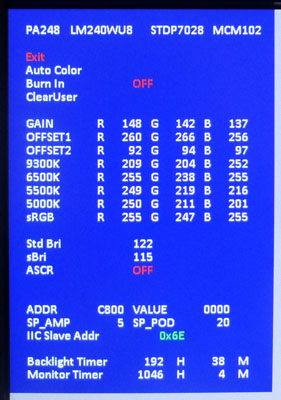
Panel Coating
The
screen coating on the PA248Q is an old style AG coating from IPS panels. It
is an older panel and so the AG coating could be described as being 'heavy' or
grainy. Some people find this to be problematic when viewing a lot of light
content, particularly white backgrounds of office documents and spreadsheets.
Many people though do not find it an issue and it's been used on IPS panels for
many years. It should be noted that some modern IPS panels have reverted to a
lighter, "cleaner" AG coating instead.
Backlighting and Colour Gamut
The screen uses a White-LED (W-LED) backlight unit
which has become very popular in today's market. This helps reduce power
consumption compared with older CCFL backlight units and brings about some
environmental benefits as well. The W-LED unit offers a standard colour gamut
which is approximately equal to the sRGB colour space. Studying the details
panel spec sheet confirms a colour space coverage of 71% NTSC, 74.3% Adobe RGB
and 95.8% sRGB. Anyone wanting to work with wider colour spaces would need to consider
wide gamut CCFL screens, or perhaps the new range of GB-LED backlit displays.
Backlight
Dimming and Flicker
We tested the screen to establish the methods used
to control backlight dimming. Our in depth article talks in more details about a
common method used for this which is called
Pulse Width Modulation (PWM). This in itself gives cause for concern to some
users who have experienced eye strain, headaches and the likes as a result of
the flickering backlight caused by this technology. Previously we have used a
camera based method as described in the article to capture results at brightness
settings of 100, 50 and 0. We now have a more advanced photosensor +
oscilloscope system which will allow us to measure backlight dimming control
with more accuracy and ultimately more ease. These tests allow us to establish
1) Whether PWM is being used to control the
backlight
2) The frequency at which this operates if used
3) Whether a flicker may be introduced or potentially noticeable at certain
settings.
The higher this frequency, the less likely you are
to see artefacts and flicker. The duty cycle (the time for which the backlight
is on) is also important and the shorter the duty cycle, the more potential
there is that you may see flicker. As a backlight is dimmed, the duty cycle
typically becomes shorter and so flicker may be more apparent at lower settings.
Please remember that not every user would notice a flicker from the backlight
but it is something to be wary of. It is also a hard thing to quantify as it is
very subjective when talking about whether a user may or may not experience the
side effects. We are able to at least measure the frequency of the backlight
using this method and tell you whether the duty cycle is sufficiently short at
certain settings that it may introduce a flicker to those sensitive to it.
100%
50%
0%



Scale = 1
horizontal grid = 5ms
Our tests confirm the use of PWM for backlight
dimming. At a maximum 100% brightness there is a constant voltage applied to the
backlight and it remains continuously lit, as shown by the steady, flat line. As
you reduce the brightness however the backlight is controlled by PWM. From a
brightness setting of 80% and below
the modulation is 100%, i.e. the backlight is turned completely off and there is no
light output while in the 'off' stage. This is evident from the oscillographs
where the troughs reach down to 0V on the vertical scale (i.e. no light output).
From there, with the modulation remaining constantly at 100% throughout the brightness adjustment
range down to the 0% setting, the light output is controlled through a reduction in the duty cycle,
that being the time for which the backlight is in an 'on' state. This gets
progressively shorter until you reach a 0% brightness setting. This can be seen
in the oscillographs as the upper peaks are shorter at 0% brightness than at 50%
brightness. The PWM operates at a fixed frequency of 180Hz. Given the relatively
low frequency and the use of a W-LED backlight unit, this may present problems
to some users who are susceptible to flicker and eye issues. If you're looking
for a screen without PWM then please see our
flicker free monitor database.
|
Pulse Width
Modulation Used |
Yes |
|
Cycling
Frequency |
180Hz |
|
Possible
Flicker at |
|
|
100% Brightness |
No |
|
50% Brightness |
Yes |
|
0% Brightness |
Yes |

Testing
Methodology
An
important thing to consider for most users is how a screen will perform out of
the box and with some basic manual adjustments. Since most users won't have
access to hardware colorimeter tools, it is important to understand how the
screen is going to perform in terms of colour accuracy for the average user.
I
restored my graphics card to default settings and disabled any previously active
ICC profiles and gamma corrections. The screen was tested at default factory settings using the DVI interface, and analysed using
an
X-rite i1
Pro Spectrophotometer (not to be confused with the new i1 Display Pro
colorimeter) combined with
LaCie's Blue Eye Pro software suite. An NEC branded and customised X-rite i1 Display 2 colorimeter was
also used to verify the black point and contrast ratio since the i1 Pro is less
reliable at the darker end.
Targets for these tests are as follows:
-
CIE Diagram - validates the colour space
covered by the monitors backlighting in a 2D view, with the black triangle representing the
displays gamut, and other reference colour spaces shown for comparison
-
Gamma - we aim for 2.2 which is the default
for computer monitors
-
Colour temperature / white point - we aim
for 6500k which is the temperature of daylight
-
Luminance - we aim for 120
cd/m2, which is
the recommended luminance for LCD monitors in normal lighting conditions
-
Black depth - we aim
for as low as possible to maximise shadow detail and to offer us the best
contrast ratio
-
Contrast ratio - we aim
for as high as possible. Any dynamic contrast ratio controls are turned off here
if present
-
dE average / maximum -
as low as possible.
If DeltaE >3, the color displayed is significantly different from the
theoretical one, meaning that the difference will be perceptible to the
viewer.
If DeltaE <2, LaCie considers the calibration a success; there remains a
slight difference, but it is barely undetectable.
If DeltaE < 1, the color fidelity is excellent.

Default Performance and
Setup
Default settings of the screen were as follows:
|
Monitor OSD Option |
Default Settings |
|
Brightness |
50 |
|
Contrast |
80 |
|
Preset Mode |
Standard |
|
RGB |
n/a |
|
Gamma |
2.2 |
|
Color Temp |
6500k |

Asus PA248Q - Default Settings



|
|
Default Settings |
|
luminance (cd/m2) |
178 |
|
Black Point (cd/m2) |
0.21 |
|
Contrast Ratio |
846:1 |
Default setup of the screen was reasonable in some
regards, but a little lacking in some areas. When you first connect up the
screen you at least had a reasonable brightness setting (50% in the OSD) which
meant it was not overly bright or difficult to use. That's quite rare for
desktop monitors really, which normally come out of the box with an excessively
bright setting. The image did feel a little cool perhaps but overall it looked
pretty good to the naked eye. The screen is in the 'standard' preset mode by
default, so we will test the factory calibrated sRGB mode
in a moment
as well.
The
CIE diagram on the left of the image confirms that the monitors colour gamut
(black triangle) is a very close match to the sRGB reference (orange triangle). This
confirms the use of a standard gamut W-LED backlight. There is some slight
over-coverage in greens and some slight under-coverage in reds, but nothing
significant at all.

Default gamma was recorded at 2.4 average, leaving
it a little out with a 8% deviance from the target of 2.2 which wasn't too bad
but not ideal. This was farthest out in the lighter grey shades. White point was too cool compared with the 6500k target, being measured at
7739k with a 19% deviance.
Luminance was recorded at a modest 178
cd/m2 which is
still a little too high for prolonged general use, but at least is not blinding. The screen was set at a default
50%
brightness in the OSD menu and is easy to change of course to reach a more
comfortable setting either more or less bright, depending on your needs. The
black depth was 0.21 cd/m2, giving us a
good static contrast ratio of
846:1.
Colour accuracy was pretty good as well with an
average dE of 2.7, and a maximum of 6.6.
Testing the screen with various gradients showed very smooth transitions with no sign
of any banding thankfully. There was some very slight gradation evident in
darker tones as you will see from most monitors and you could just about pick
out the FRC if you looked very closely. Not something you'd notice in day to day
use at all though and it is well implemented here.

Factory Calibration
The PA248Q comes factory calibrated in its sRGB
preset mode.
To ensure that each PA248Q produces the most
accurate and consistent colour, Asus carefully measure its ∆E (dE) and gamma
value and track its grey-scaling. It also supports both Gamma 2.2 for PC and
Gamma 1.8 modes for Mac, offering users more flexibilities to work with. Each
screen has been calibrated to minimize colour difference to ∆E (Delta E) of less
than 5. It comes packaged with a unique calibration report for your particular
screen as well, as shown below.
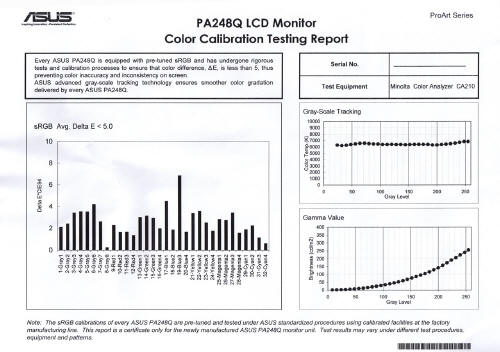
Above: factory
calibration report, click for larger version
We wanted to measure the performance in this mode as well. The default settings of the screen
in the sRGB preset were as follows. You will note you have far more restricted
control over the OSD here, with brightness being the only setting you can
change.
|
Monitor OSD Option |
Default Settings |
|
Brightness |
50 |
|
Contrast |
n/a |
|
Preset Mode |
sRGB |
|
RGB |
n/a |
|
Gamma |
n/a |
|
Color Temp |
n/a |

Asus PA248Q - Default Factory Calibration, sRGB
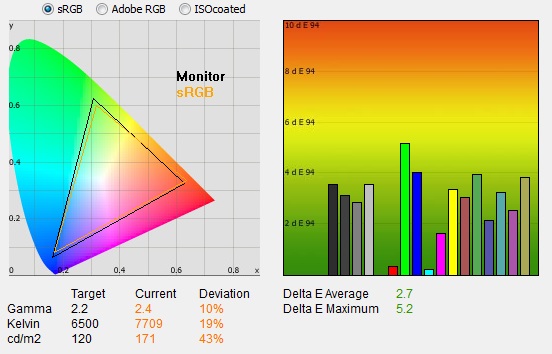
|
|
Default Settings, Factory
calibration |
|
luminance (cd/m2) |
171 |
|
Black Point (cd/m2) |
0.19 |
|
Contrast Ratio |
906:1 |
The results were not really that different to the
'standard' mode to be honest. The gamma remained at 2.4 average with a slightly
higher deviance even at 10%. The white point was also still too cool with a 19%
deviance (7709k) as we had seen before. Colour accuracy had improved a little
with a dE average of 2.7 still, but reducing some of the highest variances,
bringing maximum dE down to 5.2. The contrast ratio had also improved a little
to 906:1 which was very good for an IPS panel. All in all, we were hoping for a
slightly better gamma and white point setup to be honest from this factory
calibration, although the colour accuracy lived up to its promises.

Colour Temperatures
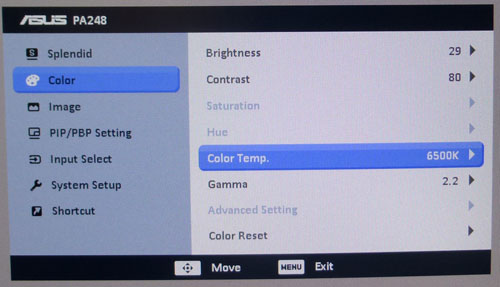
The PA248Q features a selection of colour
temperature presets within the OSD 'Color' menu as shown above. We measured the screen
with the X-rite i1 Pro spectrophotometer in each of the available modes to establish
their colour temperature / white point out of the box, compared with the target. All other settings were left at factory defaults and no
ICC profile was active. The results are recorded below:
|
Selected Preset Mode (k) |
Measured Colour Temperature (k) |
Deviance from target (k) |
Deviance |
|
5000 |
5233 |
+233 |
+4.7% |
|
5500 |
5987 |
+487 |
+8.9% |
|
6500 |
7857 |
+1357 |
+20.9% |
|
9300 |
14,695 |
+5395 |
+58.0% |
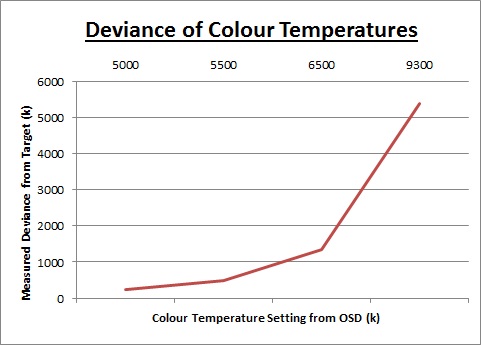
There are only 4 colour temperature modes
available from the OSD. The warmer settings of 5000k and 5500k were quite
close to their target temperatures in practice, although the 6500k showed a
fairly high deviance of ~20.9%, being too cool unfortunately. The 9300k mode
was far too cool at 14,695k, and gave a very large deviance of 58%. It would
have been nice to see a slight more accurate setup here, especially for the
widely used 6500k temperature. It might also have been useful to see a couple
more options perhaps. As it stands, there's no easy way to obtain a white
point that close to 6500k without a calibration device. The 5500k setting
would probably be the best option as it is more like 5987k in reality, and
just a little too warm.

Calibration
We used the
X-rite i1 Pro spectrophotometer combined with the LaCie Blue Eye Pro
software package to achieve these results and reports. An NEC branded and
customised X-rite i1 Display 2 was used to validate the black depth and contrast
ratios due to lower end limitations of the i1 Pro device.
|
Monitor OSD Option |
Calibrated Settings |
|
Brightness |
23 |
|
Contrast |
80 |
|
Preset Mode |
User 1 |
|
RGB (Gain) |
50, 47, 44 |
|
Gamma |
2.2 |
|
Color Temp |
6500k |

Asus PA248Q - Calibrated Settings, User Preset
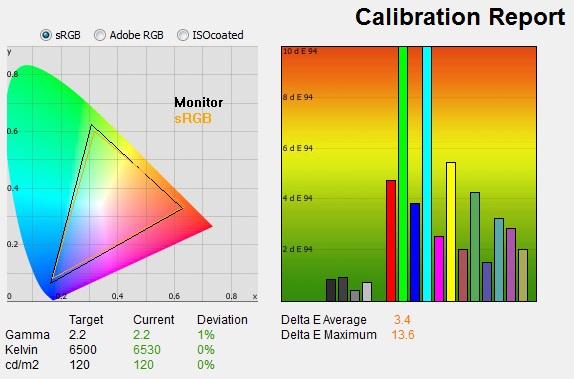
|
|
Calibrated Settings, User
Preset |
|
luminance (cd/m2) |
120 |
|
Black Point (cd/m2) |
0.14 |
|
Contrast Ratio |
857:1 |
We first of all reverted to the 'user 1' preset
mode in the OSD menu which
would allow us access to the individual RGB channels. There is also a 'user 2'
mode if you want to set up another preset to different settings. Adjustments
were made during the process to the brightness control, and to the RGB channels
(gain) as shown in the table above. This allowed us to obtain an
optimum hardware starting point and setup before software level changes would be
made at the graphics card level. This would help preserve tonal values and limit
banding issues. After this we let the software carry out the LUT adjustments and create an
ICC profile.
Average gamma had been corrected to 2.2, correcting the default
8% deviance we'd
found out of the box in the standard preset mode and leaving only a small 1%
deviance. The white point was also
corrected to 6530k, sorting out the pretty large 19% deviance from before. Luminance had also been
improved thanks to the adjustment to the brightness control, now being measured at 120
cd/m2. This
gave us a calibrated black depth of 0.14 cd/m2, and a
static contrast ratio of 857:1 which was very good for an IPS panel.
Colour
accuracy was a problem though and despite numerous attempts, and numerous
calibration tools, we were unable to
obtain a satisfactory result. We tried different OSD settings and each time it
seems the resulting colours were not as accurate as they should be. This left us
with high dE differences but it was not clear why this was the case. This is a
shame, as the 'user' presets given you access to the 6-axis colour adjustment
which should in theory allow you more control over the hardware settings. As it
was, the issues in this preset meant these user modes were largely pointless.
Having seen other tests of this screen in the past, we aren't the only ones
who've had this issue.
We wanted to see what we could do in the other
preset modes, hoping that we could achieve better results.
|
Monitor OSD Option |
Calibrated Settings |
|
Brightness |
20 |
|
Contrast |
80 |
|
Preset Mode |
Standard |
|
RGB (Gain) |
n/a |
|
Gamma |
2.2 |
|
Color Temp |
6500k |

Asus PA248Q - Calibrated Settings, Standard Preset
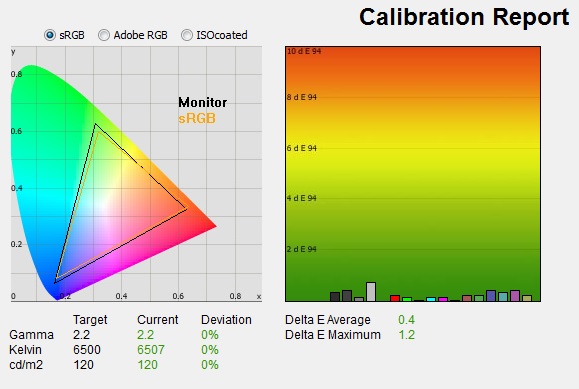
|
|
Calibrated Settings,
Standard preset |
|
luminance (cd/m2) |
120 |
|
Black Point (cd/m2) |
0.14 |
|
Contrast Ratio |
856:1 |
We then carried out a software calibration in the
'standard' preset mode. In this mode you have more limited control over the OSD
settings, with the RGB channels not being available. We adjusted the brightness
control as suggested in the process, but then let the calibration device carry
out the rest of the corrections and adjustments at the graphics card LUT level.
Gamma, white point and luminance targets had all
been met nicely as you can see. Contrast ratio was still very good at 856:1
which was pleasing. Best of all colour accuracy had also been corrected very
well, with an average dE of only 0.4. LaCie would consider colour fidelity to be
excellent. Testing the screen with various colour gradients showed smooth
transitions on the most part, with some slight banding introduced in the darker
tones due to the adjustments made at the graphics card level. This preset mode
did seem to allow for a better calibration for some reason, and so should
probably be used if you have access to a calibration device.
You can use our settings and
try our calibrated ICC profile if you wish, which are available in
our ICC profile database. Keep in mind that results will vary from one
screen to another and from one computer / graphics card to another.

Calibration
Performance Comparisons

The comparisons made in this section try to give
you a better view of how each screen performs, particularly out of the box which
is what is going to matter to most consumers. When comparing the default factory
settings for each monitor it is important to take into account several
measurement areas - gamma, white point and colour accuracy. There's no point
having a low dE colour accuracy figure if the gamma curve is way off for
instance. A good factory calibration requires all 3 to be well set up. We have
deliberately not included luminance in this comparison since this is normally
far too high by default on every screen. However, that is very easily controlled
through the brightness setting (on most screens) and should not impact the other
areas being measured anyway. It is easy enough to obtain a suitable luminance
for your working conditions and individual preferences, but a reliable factory
setup in gamma, white point and colour accuracy is important and not as easy to
change accurately without a calibration tool.
From these comparisons we can also compare the
calibrated colour accuracy, black depth and contrast ratio. After a calibration
the gamma, white point and luminance should all be at their desired targets.

Default setup of the PA248Q was not perfect, but
not too bad in some areas. There was a small variance in the gamma at 8% which
could only really be corrected properly through the use of a colorimeter. There
are no controls to tweak the gamma at a finite level in the OSD unfortunately.
White point was the main issue with the out-of-the-box setup, being a rather
large 19% out from the target and being too cool (blue) by default. Again this
wasn't easy to correct through the OSD. You could obtain a white point at ~6000k
if you switch to the 5500k preset mode, which brings it closer to the 6500k
target, but now being a little too warm. Colour accuracy was not too bad with a
dE average of 2.7 out of the box which was reasonable at least.


The calibrated black depth and contrast ratio of
the screen were very good for an IPS panel. The 856:1 contrast ratio was one of
the higher figures we'd seen from IPS technology really and so we were pleased
with this result. We had already seen a good solid performance from this
LG.Display LM240WU8 panel from its use in the Dell U2412M (947:1) and HP ZR2440w (935:1)
which had reached a slightly higher calibrated contrast ratio than the Asus, but
not by much. Of course IPS can't compete with the mega high contrast ratios of
modern AMVA panels which reach up to 2000 - 3000:1 as you can see. Nevertheless
a decent enough performance from the PA248Q here considering its panel
technology of choice.
|
Check Pricing and Buy - Direct Links
|
|
Amazon USA |
Amazon UK |
Amazon GER |
Amazon CAN
|
|
TFTCentral is a participant
in the Amazon Services LLC Associates Programme, an affiliate
advertising programme designed to provide a means for sites to earn
advertising fees by advertising and linking to Amazon.com, Amazon.co.uk,
Amazon.de, Amazon.ca and other Amazon stores worldwide. We also
participate in a similar scheme for Overclockers.co.uk. |

Contrast
Stability and Brightness
We wanted to see how much variance there was in
the screens contrast as we adjusted the monitor setting for brightness.
In theory, brightness and contrast are two independent parameters, and good
contrast is a requirement regardless of the brightness adjustment.
Unfortunately, such is not always the case in practice. We recorded the
screens luminance and black depth at various OSD brightness settings, and
calculated the contrast ratio from there. Graphics card settings were left at
default with no ICC profile or calibration active. Tests were made using an
NEC branded and customised
X-rite i1 Display 2 colorimeter. It should be noted that we used the
BasICColor calibration software here to record these, and so luminance at
default settings may vary a little from the LaCie Blue Eye Pro report.
|
OSD
Brightness |
Luminance
(cd/m2) |
Black
Point (cd/m2) |
Contrast
Ratio
( x:1) |
|
100 |
290.53 |
0.34 |
854 |
|
90 |
267.34 |
0.31 |
862 |
|
80 |
244.27 |
0.28 |
872 |
|
70 |
222.92 |
0.26 |
857 |
|
60 |
199.88 |
0.23 |
869 |
|
50 |
177.74 |
0.21 |
846 |
|
40 |
158.38 |
0.18 |
880 |
|
30 |
140.28 |
0.16 |
877 |
|
20 |
121.90 |
0.14 |
871 |
|
10 |
103.41 |
0.12 |
862 |
|
0 |
84.75 |
0.10 |
848 |
|
Total Luminance Adjustment Range
(cd/m2) |
205.78 |
Brightness OSD setting controls backlight? |
 |
|
Total Black Point
Adjustment Range (cd/m2) |
0.24 |
|
Average Static Contrast Ratio |
863:1 |
PWM Free? |
 |
|
Recommended OSD setting for 120 cd/m2 |
19 |
The luminance range of the screen was good. At the
maximum brightness setting the screen reached 290.53
cd/m2, which was only slightly lower than
the specified 300 cd/m2 maximum. At the lower end of the adjustment range you could reach down to
84.75 cd/m2. This should be ok for most users, but perhaps might not
be dark enough for some who want to use the screen in very low lighting
conditions. The total adjustment range of 205.78 cd/m2 was good, but we would
have perhaps preferred a lower minimum brightness and a lower maximum brightness
overall. As we discussed earlier, the backlight dimming is achieved through the
use of PWM dimming and so those prone to any issues with backlight
flickering should be cautious.

We have plotted the
luminance trend on the graph above. The screen behaves as it should, with a
reduction in the backlight intensity controlled by the reduction in the OSD
brightness setting. This was pretty much a linear relationship.

Average contrast ratio measured was 863:1
which was very good for an IPS panel. This remained nice and stable across the
brightness adjustment range as shown above.

Dynamic Contrast
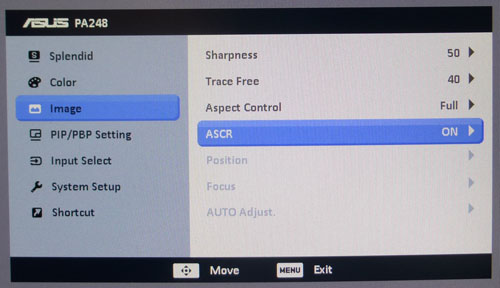
The Asus PA248Q features a dynamic contrast ratio
(DCR) control, which boasts a spec of 80,000,000:1 (80 million:1). Dynamic
contrast ratio involves controlling the backlight of the screen automatically,
depending on the content shown on the screen. In bright images, the backlight
is increased, and in darker images, it is decreased. We have come to learn
that DCR figures are greatly exaggerated and what is useable in reality is
often very different to what is written on paper or on a manufacturers
website.
For this test we would use a colorimeter to record the
luminance and black depths at the two extremes. Max brightness would be
recorded on an almost all white screen. Black depth would
be recorded on an almost all black screen. In real use you are very
unlikely to ever see a full black or full white screen, and even our tests are
an extreme case to be honest. Carrying out the tests in this way does give you
a good indication of the screens dynamic contrast ratio in real life
situations however.
The DCR feature is available in the Scenery and
Theater preset modes. It has a simple setting for off and on, and is labelled
as "ASCR" (Asus Smart Contrast Ratio) in the 'Image' section of the OSD.
|
|
Dynamic Contrast |
|
Specified DCR Range |
80 Million:1 |
|
Available in Presets |
Scenery, Theater |
|
Setting Identification / Menu option |
ASCR |
|
Settings |
off / on |
|
Measured
Results |
Scenery |
Theater |
|
Default Static Contrast Ratio |
811:1 |
493:1 |
|
Max luminance (cd/m2) |
293.86 |
137.41 |
|
Min Black Point (cd/m2) |
0.37 |
0.37 |
|
Max Dynamic Contrast Ratio |
794:1 |
371:1 |
|
Useable DCR in practice |
No |
No |
|
Backlight turned off for 100% black |
Yes |
Yes |
We tested the DCR feature in both of the preset
modes. By default the Scenery preset mode gave us a static contrast ratio
similar to that which we'd measured in the standard default preset mode.
However, with DCR enabled the brightness of the screen was very high at 293.86
cd/m2. The DCR seemed to do nothing at
all though when switching between an almost all-white and almost all-black
screen which was a shame. If you switch to a 100% black image , you can see the
backlight starts to dim, and after 5 seconds it is turned off completely. Given
that you're unlikely to ever get a 100% black image in practice, this feature
seems pointless and is more of a marketing number than anything else. The high
80 million:1 spec is achieved in the lab when the backlight is turned off, but
in day to day use you're never going to be able to use it. The 'Theater' mode
was a similar story, with the DCR not doing anything in practice. In fact the
static
contrast ratio was crushed quite a lot in this mode to around 400:1 so it wasn't
very desirable. Again the backlight is turned off completely, this time after
~10 seconds but again useless in practice.

Viewing Angles

Above: Viewing
angles shown from front and side, and from above and below. Click for
larger image
Viewing angles of the PA248Q were very good as you
would expect from an IPS panel. Horizontally there was very little colour tone
shift until wide angles past about 45°. A slight darkening of the image occurred
horizontally from wider angles as you can see above as the contrast shifted
slighting. Contrast shifts were slightly more noticeable in the vertical field
where a slight pink-ish hue also appeared, but overall they were very good. The
screen offered the wide viewing angles of IPS technology and was free from the
very restrictive fields of view of TN Film panels, especially in the vertical
plane. It was also free of the off-centre contrast shift you see from VA panels
and a lot of the quite obvious gamma and colour tone shift you see from some of
the modern AMVA and PVA offerings. All as expected really from a modern IPS
panel. On a black image there is a characteristic IPS white glow introduced to
the image when viewed from a wide angle. This may be problematic to some users
working with a lot of dark content, or in darkened room conditions.

Panel Uniformity
We wanted to test
here how uniform the brightness and colour temperature was across the screen, as well as identify any
leakage from the backlight in dark lighting conditions. Measurements of the luminance
and colour temperature were taken at 35 points across the panel on a pure
white background. The measurements for luminance were taken using BasICColor's calibration
software package, combined with the NEC customised X-rite i1 Display 2
colorimeter with a central point on the screen calibrated to 120 cd/m2. Measurements for colour temperature (white point) were taken using
BasICColor software and the i1 Pro spectrophotometer which can more accurately
measure white points of different backlighting technologies. The below uniformity diagram shows the difference, as a percentage,
between the measurement recorded at each point on the screen, as compared with the
central reference point.
It is worth
noting that panel uniformity can vary from one screen to another, and can depend
on manufacturing lines, screen transport and other local factors. This is only a
guide of the uniformity of the sample screen we have for review.

Uniformity of Luminance
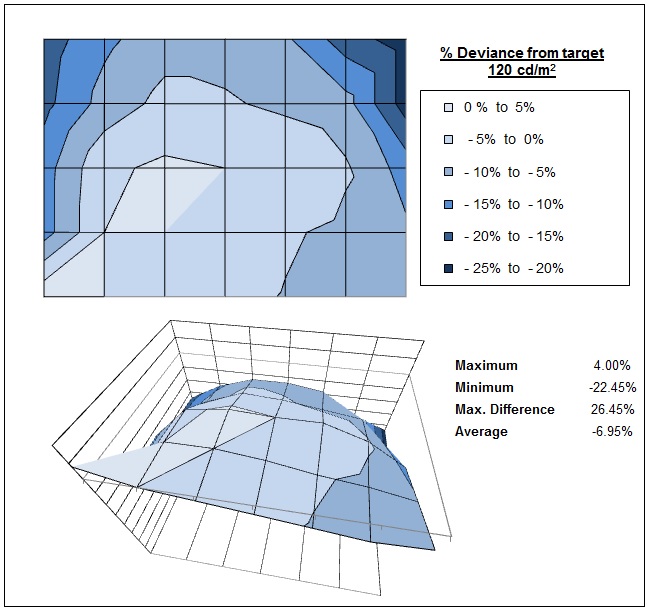
The luminance uniformity of the screen was
moderate overall. There did seem to be some darker regions in the top
corners, where luminance dropped by a maximum of 22.45%, down to around 98
cd/m2
in the most extreme case. The bottom left hand corner was also a little
brighter than than the middle of the screen, at ~4% more, and 125 cd/m2.
Nothing too severe, but not optimum if you were doing colour critical work.

Uniformity of White Point / Colour
Temperature
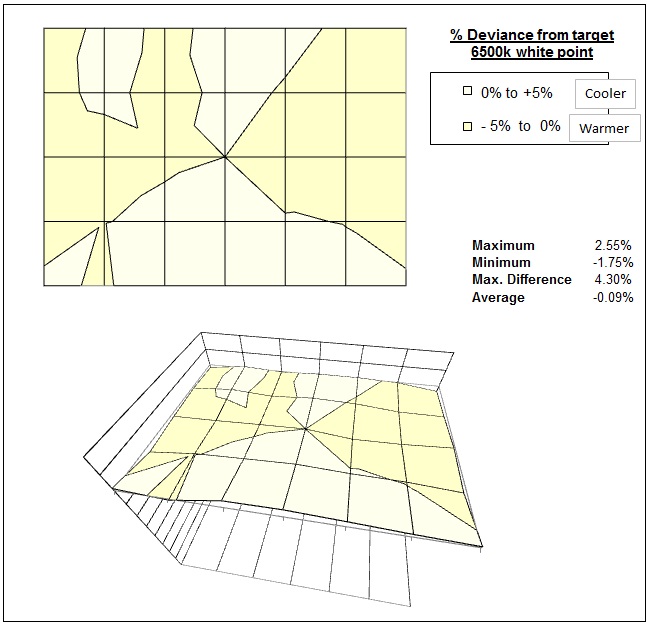
The colour temperature uniformity was measured
based on a centrally calibrated 6500k point. As you can see, the colour
temperature was very stable across the screen, with only very small
differences of a few percent. This should provide a good uniformity when
working with colours and gradients and presented no problems.

Backlight Leakage
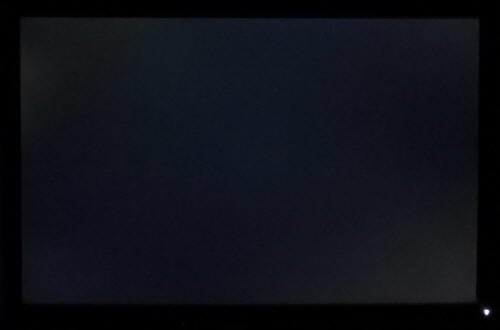
Above: All black screen in a darkened room. Click for larger version
As usual we also tested the screen with an all
black image and in a darkened room. A camera was used to capture the result.
There was no obvious backlight bleeding at all to the naked eye and the
uniformity looked very good, even in a darkened room. The camera captured some
slight clouding from the corners, but this was very minimal and not something
which you should notice in practice.

General and Office Applications

The 1920 x 1200 resolution and 24" screen size
give a nice decent area in which to work and the vertical resolution is a little
more than the wide range of 16:9 aspect 24" models (1920 x 1080) out there in
the market. A lot of people prefer this extra vertical area and it is useful for
office applications we think. You may want to consider the fact that high
resolution 27" 2560 x 1440 models are becoming increasingly available and so the
difference in desktop size is certainly noticeable coming from a 27" screen like
that. Nevertheless, the 24" 1920 x 1200 resolution should be adequate for many
users. The screen offered a comfortable 0.27mm pixel pitch which delivered easy
to read text at a nice size, in my opinion. The resolution is certainly big
enough for side by side split screen working as well in many cases.
The digital DVI interface offered a slightly
sharper image quality than the D-sub analogue interface and so should be used
wherever possible for your PC connection. The old style 'heavy' AG coating means
that the white backgrounds of office applications don't look as 'clean' as some
other panels we've tested, although it doesn't appear overly aggressive here to
be honest. Default luminance of the screen was recorded at 178
cd/m2 which is a bit too high for
prolonged office use. You will want to turn the screen down probably to around
19 - 20% brightness to achieve a luminance of around 120 cd/m2. Those
wanting to use the screen in darker room conditions and at a luminance lower
than this can do so through further adjustment to this setting, down to around
85 cd/m2 minimum which might be restrictive in some cases, but
should be adequate for most users. The backlight dimming
is achieved through the use of
PWM and so those affected by flicker or eye
issues should be cautious when considering this screen.
There is no
specific preset mode available for reading or internet use, or anything like
that, so you will want to set up one of the other modes to suit. The default
white point is a little too cool unfortunately, with no easy way to correct it
without a calibration device. Reverting to the 5500k mode in the OSD menu
might be preferable as it is closer to the 6500k target, but a little warmer at
~6000k, and so might be more comfortable for reading and office work (warmer
tends to be a little easier on the eye). Gamma is also a little out from the 2.2
target and again there's no easy way to correct this without a calibration
device. The factory calibrated sRGB mode isn't really any better sadly, despite
the marketing hype. If you bought the PA248QJ version of the screen the packaged
Spyder4 device and software should allow you to obtain a more accurate setup
though thankfully. Obviously it can also be paired with any other calibration
package you might want to buy or already have.
The screen features 4x USB 3.0 ports which is useful,
and the stand provides a very wide range of adjustments which is pleasing. There
are no other added functions such as ambient light sensors, card readers or human
motion sensors here. Asus do have their own "Quick Fit" grid which is accessible
by pressing the 5-axis control stick button. This pops up a series of different
sized grids on the screen to allow you to check the sizes of your work more
accurately.

Above: photo of text at 1920 x 1200 (top) and 1680 x 1050 (bottom)
The screen is designed to run at its native
resolution of 1920 x 1200 and at a 60Hz recommended refresh rate. If you want
you are able to run the screen outside of this resolution of course. We tested
the screen at a lower 1680 x 1050 resolution while maintaining the same aspect
ratio (16:10) to see how the screen handles the interpolation of the resolution.
At native resolution the text was sharp as you can see from the top photograph.
When
you switch to a lower resolution the text is larger of course but maintains much
of its sharpness and does not look overly blurry. There was fairly low
levels of overlap of the pixels and text was still very readable. Native
resolution is recommended where possible of course but the screen can
interpolate lower resolutions nicely.

Responsiveness and Gaming
The PA248Q is rated by Asus as having a 6ms G2G response time which implies the use of
overdrive /
response time compensation (RTC) technology, used to boost pixel transitions
across grey to grey changes. The
part
being used is the
LG.Display LM280WU8-SLA2 e-IPS panel. Have a read about response time in
our
specs section if you need additional information about this measurement.
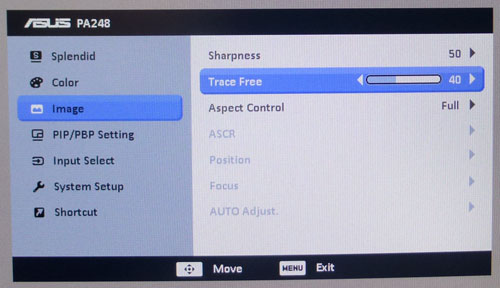
There is a user controllable option in the OSD for
the overdrive function, labelled as 'Trace Free'. There are settings in steps of
20 between 0 and 100. We will first test the screen using our thorough
response time testing method. This uses an oscilloscope and photosensor to
measure the pixel response times across a series of 20 different transitions, in
the full range from 0 (black) to 255 (white). This will give us a realistic view
of how the monitor performs in real life, as opposed to being reliant only on a
manufacturers spec. We can work out the response times for changing between many
different shades, calculate the maximum, minimum and average grey
to grey (G2G) response times, and provide an evaluation of any overshoot present
on the monitor.
We use an
ETC M526
oscilloscope for these measurements along with a custom photosensor device.
Have a read of
our response time measurement article for a full explanation of the testing methodology and reported
data.
Trace Free Setting Comparison

We first of all tested the screen with Trace Free
turned off, at a setting of 0. As you can see from the results in this sample of
measurements, the response time was not that great. Average G2G was only 13.6ms
which wasn't that good and the rise times in the upper right hand region
(changes from dark to light shades) were quite a lot slower than the fall times
(changes from light to darker tones). Some ranged up around 20ms which was
pretty poor. At least at this setting there was no RTC overshoot at all,
although the response times were too slow really for our liking.
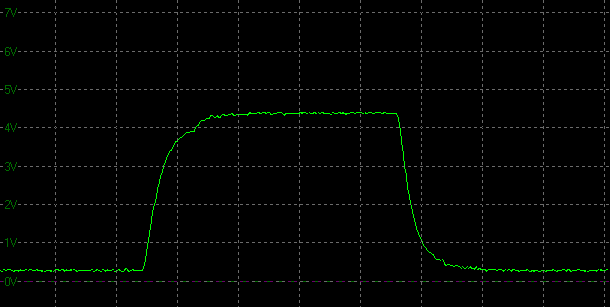
Transition: 50-255-50 (Trace Free
0)
(scale = 20ms)
Above is a typical response time graph for Trace
Free 0, showing smooth transitions between the start and end points, freedom
from any overshoot spikes, but a slower rise time than fall time.

If we change up to the Trace Free setting of 20
there is some improvement with the response times. The average G2G response time
improves to 10ms from 13.6ms which is better, and there's some noticeable improvements in
the rise times. Where this has improved the most in this measurement sample (the transition
from 0 - 50), the response time has improved from 20.1ms (Trace Free 0) to 6.8ms
(Trace Free 20). However, in doing so, a large RTC error of 40.2% has been
introduced, causing a large overshoot of the desired shade. This Trace free
setting of 20 seems to have boosted the rise times a little, but some
transitions between darker shades now show some overshoot as a result. It's not a massive
amount and on the whole there's no major issue.
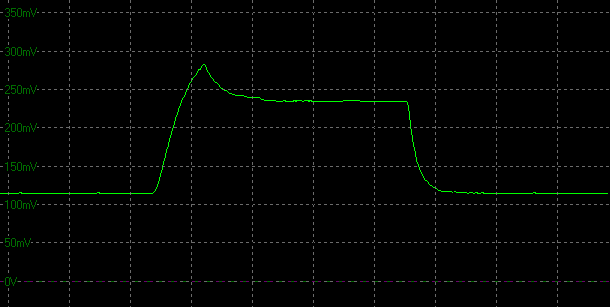
Transition: 0-50-0 (Trace Free 20)
(scale = 20ms)
The above graph shows the 0-50-0 transition where
you can see the overshoot spike on the rise time clearly (40.2% overshoot).

Switching up to the next setting of 40 showed
another slight improvement in response time, with G2G average now 9.1ms. There
was slightly more overshoot in some transitions, but at a low level of only 4 -
5%. Some dark transitions continued to show a significant overshoot where pixel
response times had been improved most significantly. For example the 0-50
transition still showed an RTC error of 49.5% here which was high. This setting
did seem to offer a slight improvement over Trace Free 20, without much real
negative impact in the form of overshoot.

Trace Free 60 was a fairly drastic change from 40,
but it was too aggressive sadly. The response times had been improved quite a
lot by ~33%, with an average G2G of 6.8ms now. However, the RTC errors were
becoming very problematic and noticeable in practice. More large errors of
20-40% crept in, particularly in the rise times where response times had been
boosted the most from the overdrive impulse. We felt the additional improvement
in response times was not worth it at the cost of the noticeable overshoot
problems at this setting. The setting of 40 seemed an optimum balance we felt.
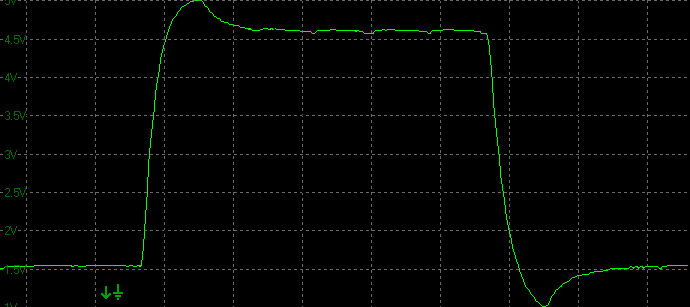
Transition: 150-255-150 (Trace
Free 60)
(scale = 20ms)
As an example, the above graph shows the
150-255-150 transitions, where you can see some overshoot on both the rise and
fall times.

The Trace Free setting of 80 only made the
overshoot problems worse. There was a slight drop in response times, now down to
6.1ms, but the overshoot was even more apparent and at a higher level. In the
worst cases in this sample, the RTC error was up as high as 60%. This mode
should be avoided as a result.

Finally it was a similar story when pushing the
Trace free setting all the way up to 100. Response times dropped again to 5.4ms
now, even below the quoted 6ms G2G average from the manufacturer. However the
RTC overshoot was disastrous, with some transitions showing up as high as 92.6%!
Again, avoid this mode as the overshoot is just too problematic.
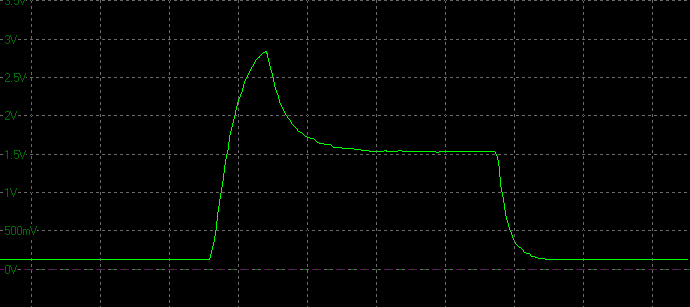
Transition:0-150-0 (Trace Free
100)
(scale = 20ms)
Here is the graph from the worst example of
overshoot, with a massive spike on the rise time of 92.6%.
Having established that Trace Free 40 seemed to
provide an optimum performance and balance, we carried out some more thorough
measurements.
Trace Free 40 Detailed
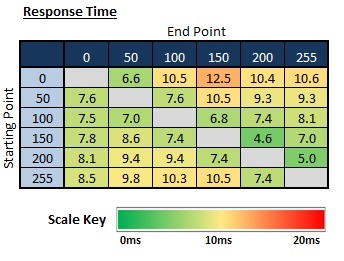 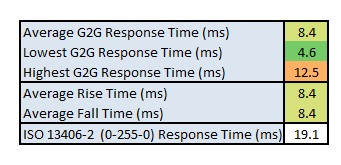
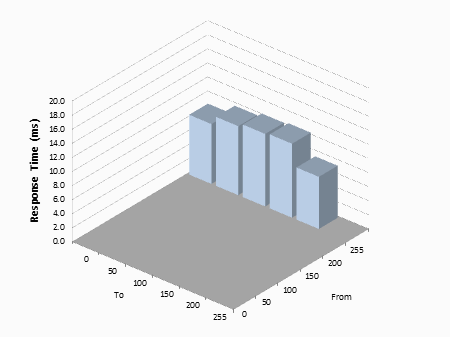
We carried out a further sample set of
measurements in the Trace free 40 setting to get an even more complete view of
the response times of the panel. Average G2G response time was a little lower
than we'd seen from our small sample set in the previous section, now being
measured at 8.4ms G2G which was moderate. The average rise (changes from dark to
light shades) and average fall (changes from light to dark shades) times was
identical at 8.4ms as well, showing a fairly consistent performance overall. The
response times were lowest where the shades were close together, for example in
the best case from a change from 150-200 at 4.6ms. However, these boosted
response times were not without issue unfortunately...
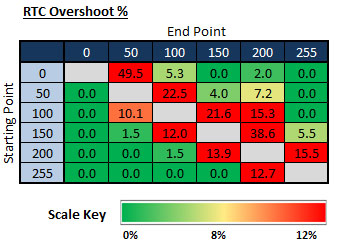
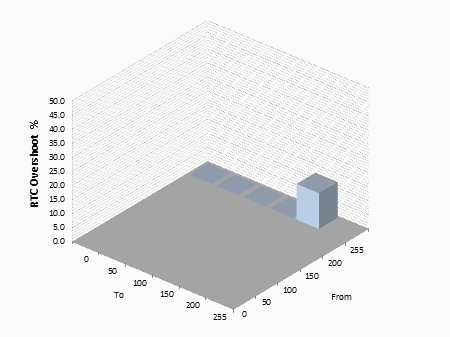
The instances where response times were lowest
unfortunately introduced some overshoot. In the most extreme case this was 49.5%
(0-50), but on the most part it was around 15 - 20% which was noticeable, but
not too severe. The overshoot only seemed a problem for the transitions between
similar shades, and the more extreme changes (e.g. 0 - 255) were slower, but
showed no overshoot. If the overshoot proves troublesome for your uses, you can
always switch down to TF20 if you like, which should cut it down somewhat, but
at the cost of slightly slower response times. Anything higher than TF40
introduces more noticeable overshoot so should probably be avoided.
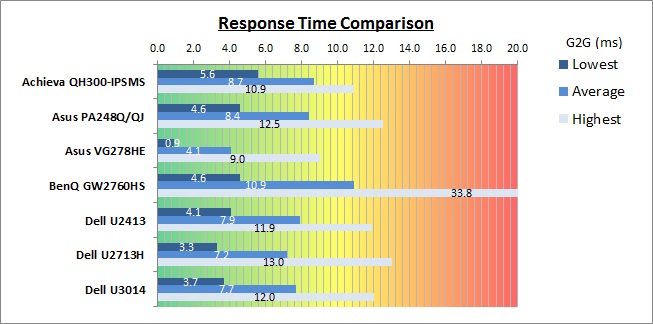
As we begin to measure more screens with the
oscilloscope system we can begin to plot them on a graph like the above for easy
comparison. This shows you the lowest, average and highest G2G response time
measurement for each screen. The Asus PA248Q performed quite similarly to the
other IPS screens we've tested here. It wasn't quite as fast as the new Dell U
series screens, but those had shown some far more problematic overshoot problems
unfortunately. The Asus was faster than the AMVA based BenQ GW2760HS but
couldn't keep up of course with the very fast gamer-orientated Asus VG278HE.
Motion Tests
The screen was also tested using the chase test in
PixPerAn. As a reminder, a series of
pictures are taken on the highest shutter speed and compared, with the best case
example shown. This should only be used as a rough guide to comparative
responsiveness, but is handy for a comparison between the different Trace Free settings
and between different screens.
Motion Tests at Each Trace Free Setting (0 -
100)

Above is a comparison of the perceived motion
performance in each of the Trace Free (TF) modes. This confirms what we had seen
with our oscilloscope measurements of response time and RTC overshoot as well as
you can see. The settings from 0, 20 and to 40 show a slight improvement in the
moving image which you can see with the naked eye as you switch between each
mode. There is a slightly less pronounced motion blur as you increase the
setting up to TF40. In this mode, there are low levels of blur to the moving
car, and no obvious overshoot problems in this test. We know from our
oscilloscope measurements that some transitions which are close together can
produce some moderately high levels of overshoot, but they aren't picked out in
these PixPerAn tests.
As you move up to TF60, a dark overshoot artefact
is introduced and noticeable to the naked eye. Behind the white speech bubble
and yellow head is a dark trail which can be a little distracting. It's not
horrible, but it does mean TF60 is a little worse than TF40 in our opinion for
moving images and gaming. TF80 and TF100 show more pronounced overshoot, where
the trails become darker, and in the case of the maximum setting, also show a
pale halo. The overshoot in these modes is very distracting and obvious and so
should be avoided.
Display Comparisons

24"WS 6ms G3G LG.Display e-IPS (Trace Free = 40)

24" 8ms G2G
LG.Display e-IPS

24" 6ms G2G
LG.Display e-IPS (Video OverDrive = On)
We can compare the PA248Q first of all against two
other 24" IPS screens we have tested, using the same LM240WU8 panel in fact.
These are of course logical competitors to the PA248Q, although the positioning
of each screen does vary a little by manufacturer. The Asus seems to be more
geared at colour enthusiasts and higher end work, although the other screens use
the same panel and so ultimately performance is quite comparable in many
regards. The three screens performed quite similarly in these motion tests,
although the Dell and HP models were more like when we had boosted the Asus
Trace Free setting up to 60. In these images you can see that the Asus has a
slightly more pronounced motion blur than the other two, but it is free (at
TF40) from the slight dark overshoot you see on the
HP
ZR2440w, and the more noticeable
dark trails you can clearly see on the
Dell
U2412M.

24"WS 6ms G3G LG.Display e-IPS (Trace Free = 40)

24" 6ms G2G
LG.Display AH-IPS

24" 4ms G2G AU
Optronics AMVA (AMA = Premium)

24" 6ms G2G AU
Optronics AMVA
We've also provided a comparison against three
other 24" models we've tested. Like the PA248Q, the
Dell U2413 is aimed primarily at higher end users and colour critical work.
The difference being that the Dell also features some other high end features
like wide gamut backlighting, 10-bit colour depth support and hardware
calibration. The Asus is a little faster when it comes to pixel responsiveness,
showing less noticeable blur in practice. While it's not shown in the PixPerAn
images here, the U2413 also suffers from some obvious overshoot problems with transitions from dark to light colours.
The
BenQ GW2450HM and
Dell S2440L are AMVA based
screens, but two of the faster models we've tested with this technology (which
is traditionally fairly slow). They both show low levels of motion blur to the
moving image, but do have a noticeable dark overshoot trail.

24"WS 6ms G3G LG.Display e-IPS (Trace Free = 40)

27" 2ms G2G Chi
Mei Innolux TN Film +144Hz (Trace Free = 60)

24" 2ms G2G AU
Optronics TN Film + 120Hz (AMA = On)

27" 1ms G2G Chi
Mei Innolux TN Film + 120Hz (Over Drive = 0)

22" 3ms G2G Samsung TN Film + 120Hz
We've also included a comparison above against
four very fast 120Hz+ compatible screens we have tested. In all cases these
other screens are using TN Film panels and are aimed primarily at gamers.
Firstly there is a comparison against the
Asus VG278HE with its 144Hz refresh
rate. This showed very fast pixel response times and smooth movement thanks to
its increased refresh rate. You are able to reduce the perceived motion blur even more
through the use of the LightBoost strobe backlight which we talked about in
depth in our article about
Motion Blur Reduction Backlights.
Then there is a comparison against the
BenQ XL2420T. This showed very low levels of motion blur, but some dark
overshoot was introduced as a side-effect. The
Iiyama G2773HS was very responsive and even has a quoted 1ms G2G response
time. This showed very low levels of blur and had minimal issue with overshoot.
The
Samsung SM2233RZ performed very well in these tests and showed very low
levels of motion blur also. When 120Hz mode was enabled the overdrive artefacts
evident in 60Hz mode were almost completely eliminated, which is something we
have seen with the BenQ XL2420T as well.
There is something else going on as well here which can't be picked out by the camera. All of these other TN Film models are
running at 120Hz (or higher) refresh rates, which allows for improved 120fps+ frame rates and
the support of
3D stereoscopic content as well. This can really help improve smoothness and
the overall gaming experience so these screens still have the edge when it comes
to fast gaming.

The responsiveness of the Asus PA248Q was pretty
reasonable. It wasn't as fast as some other panels we've tested like the fast TN
Film models of course, but for an IPS panel it was decent. The Trace Free option
allows you to control the overdrive impulse to taste, although we did find TF40
gave a good balance between reasonable response times and low levels of
overshoot. The screen had an 8.4ms average G2G response time recorded and a well
balanced performance across different transitions, both from light to dark
shades and visa versa. Some other IPS screens have given us slightly faster
response times, but normally at the cost of a more pronounced and problematic
overshoot. Those wanting to play fast FPS or competitive
games may want to consider some of the more gamer-orientated 120Hz+ compatible displays out
there. Even better still would be models equipped with
LightBoost systems for optimum motion blur elimination.

Additional Gaming Features
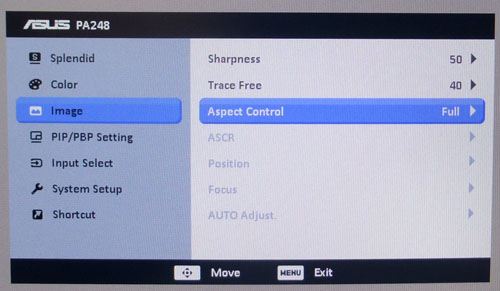
Aspect Ratio Control - The screen offers
three options for aspect ratio control. There is a 'full' option which will
always fill the screen no matter what the source resolution and aspect ratio,
stretching it in whatever way is necessary to fill the screen. There is then a
useful '1:1' option which maintains the source aspect ratio and maps the pixels
1:1 to the screen output. It would have been useful to perhaps see an "aspect"
option which maintains the aspect ratio of the source, but fills as much of the
screen as possible to give you a bigger image. A dedicated 4:3 mode is available
when you switch to a non-native resolution which isn't 16:10 or 16:9 aspect
ratio, although there isn't a 5:4 mode available.
Preset Modes - There is no specific preset mode for gaming and so you will
have to set up one of the other modes to your liking. The two 'user' modes might
be handy here. The DCR function doesn't do anything in practice which is a
shame, as some people may like that for games.

Lag
We have written an in depth article about
input lag and the various measurement techniques which are used to evaluate
this aspect of a display. It's important to first of all understand the
different methods available and also what this lag means to you as an end-user.
Input Lag vs. Display Lag vs. Signal
Processing
To avoid confusion with different terminology we
will refer to this section of our reviews as just "lag" from now on, as there
are a few different aspects to consider, and different interpretations of the
term "input lag". We will consider the following points here as much as
possible. The overall "display lag" is the first, that being the delay between
the image being shown on the TFT display and that being shown on a CRT. This is
what many people will know as input lag and originally was the measure made to
explain why the image is a little behind when using a CRT. The older stopwatch
based methods were the common way to measure this in the past, but through
advanced studies have been shown to be quite inaccurate. As a result, more
advanced tools like SMTT provide a method to measure that delay between a TFT
and CRT while removing the inaccuracies of older stopwatch methods.
In reality that lag / delay is caused by a
combination of two things - the signal processing delay caused by the TFT
electronics / scaler, and the response time of the pixels themselves. Most
"input lag" measurements over the years have always been based on the overall
display lag (signal processing + response time) and indeed the SMTT tool is
based on this visual difference between a CRT and TFT and so measures the
overall display lag. In practice the signal processing is the element which
gives the feel of lag to the user, and the response time of course can
impact blurring, and overall image quality in moving scenes. As people become
more aware of lag as a possible issue, we are of course keen to try and
understand the split between the two as much as possible to give a complete
picture.
The signal processing element within that is quite
hard to identify without extremely high end equipment and very complicated
methods. In fact the studies by Thomas Thiemann which really kicked this whole
thing off were based on equipment worth >100,1000 Euro, requiring extremely high
bandwidths and very complicated methods to trigger the correct behaviour and
accurately measure the signal processing on its own. Other techniques which are
being used since are not conducted by Thomas (he is a freelance writer) or based
on this equipment or technique, and may also be subject to other errors or
inaccuracies based on our conversations with him since. It's very hard as a
result to produce a technique which will measure just the signal processing on
its own unfortunately. Many measurement techniques are also not explained and so
it is important to try and get a picture from various sources if possible to
make an informed judgement about a display overall.
For our tests we will continue to use the SMTT
tool to measure the overall "display lag". From there we can use our
oscilloscope system to measure the response time across a wide range of grey to
grey (G2G) transitions as recorded in our
response time
tests. Since SMTT will not include the full response time within its
measurements, after speaking with Thomas further about the situation we will
subtract half of the average G2G response time from the total display lag. This should allow us to give a good estimation of
how much of the overall lag is attributable to the signal processing element on
its own.
Lag Classification
To help in this section we will also introduce a broader classification system
for these results to help categorise each screen as one of the following levels:
-
Class 1)
Less than 16ms / 1 frame lag - should be fine for gamers, even at high levels
-
Class
2)
A lag of 16 -
32ms / One to two frames - moderate lag but should be fine for many gamers.
Caution advised for serious gaming and FPS
-
Class
3)
A lag of more
than 32ms / more than 2 frames - Some noticeable lag in daily usage, not
suitable for high end gaming
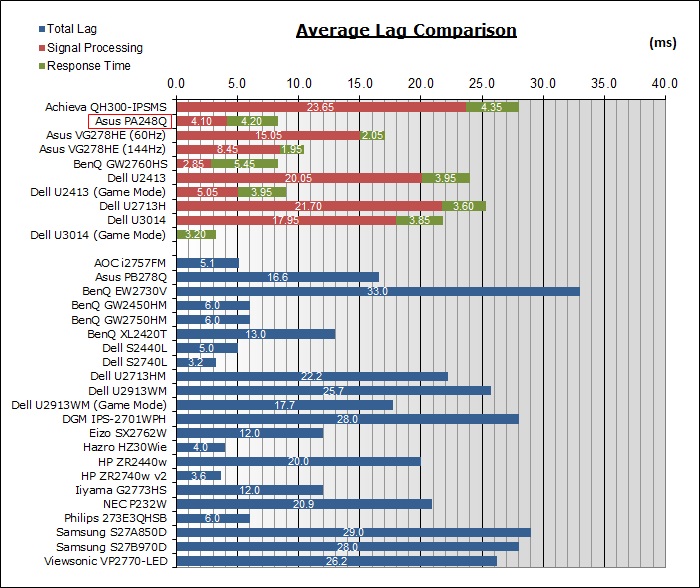
For the full reviews of the models compared here and the dates they were written
(and when screens were approximately released to the market), please see our
full
reviews index.
|
(Measurements in ms) |
Standard Mode |
|
Total Display Lag (SMTT
2) |
8.3 |
|
Pixel Response Time
Element |
4.2 |
|
Estimated Signal
Processing Lag |
4.1 |
|
Lag Classification |
1 |
|

Class
1 |
We have provided a comparison above against other models we have tested to give
an indication between screens. Those shown with blue bars represent the total
"display lag" as at the time of review we did not have access to an oscilloscope
system to measure the response time element and provide an estimation of the
signal processing. The screens tested more recently are split into two
measurements which are based on our overall display lag tests (using SMTT) and
half the average G2G response time, as measured by
the oscilloscope. The response time is split from the overall display lag and
shown on the graph as the green bar. From there, the signal processing (red bar)
can be provided as a good estimation.
The Asus PA248Q showed an average total
display lag of only 8.3ms during the initial tests. This lag was very low
overall which was pleasing, equating to around half a frame. We measured half the average G2G response time as
4.2ms and so we can estimate
that the signal processing is approximately 4.1ms. This is certainly a very low
lag and should present no problems for gaming as a result.

Movies and Video

The following summarises the screens performance
in video applications:
-
24"
screen size makes it a reasonable option for an all-in-one multimedia screen,
but being quite a bit smaller than most modern LCD TV's of course. As far as
desktop monitors go it is at the middle end nowadays.
-
16:10
aspect ratio is less well suited to videos than a 16:9 format screen, leaving
larger borders on DVD's and wide screen content at the top and bottom.
-
1920 x
1200 resolution can support full 1080 HD resolution content.
-
Digital interfaces support HDCP for any encrypted and protected content
-
As well as DVI there are
also VGA, DisplayPort and HDMI available which may be useful for
connecting external devices. HDMI is particularly useful given it is so widely
used.
-
Cables provided in the box
for everything except
HDMI which is useful, although it would have been
good to see HDMI included really.
-
AG
coating may appear too grainy or 'dirty' to some users as it is of the older
type. May be distracting to some users on lighter content, but probably not an
issue with movies and dynamic images.
-
Wide
brightness range adjustment possible from the display, including high maximum
luminance of ~291
cd/m2 and a reasonable minimum
luminance of ~85 cd/m2. This should afford you very good control
for different lighting conditions although if you are watching movies in a
very dark environment, the lower level adjustment might not be optimal.
-
Black
depth and contrast ratio are very god for an IPS panel being measured at 856:1
after calibration. Shadow detail in darker scenes should not be lost even when
watching a lot of dark content.
-
Dynamic contrast ratio available on this model but does nothing in practice
unfortunately.
-
There
is a specific 'Theater' preset available which appears overly blue and also
crushes static contrast ratio a lot. Probably should be avoided.
-
Good
pixel responsiveness which should be able to handle fast moving scenes in
movies without issue. Probably best to stick with a Trace Free setting of 20
or 40 for optimum performance and to avoid any overshoot problems.
-
Wide viewing angles thanks to IPS panel
technology meaning several people could view the screen at once comfortable
and from a whole host of different angles.
-
Very good range of ergonomic adjustments
available from the stand so should be easy to obtain a comfortable position
for multiple users or if you want to sit further away from the screen for
movie viewing.
-
No
noticeable backlight leakage, and none from the edges which is good. This type
of leakage may prove an issue when watching movies where black borders are
present but it is not a problem here.
-
No
integrated stereo speakers on this model although there is a headphone audio
connection to output the sound if using HDMI or DisplayPort.
-
Reasonable range of
hardware aspect ratio options with 'full', 1:1 and 4:3 available. At least the
screen is able to maintain whatever the source aspect ratio is using the
1:1 option.
-
Picture in picture (PiP) and Picture By Picture (PbP) are available if needed.
-
For
PAL sources, we have tested the screen and confirmed it will support
the full native resolution of 1920 x 1200 at 50Hz refresh rate.

Conclusion
Overall the Asus PA248Q seemed to be a pretty good
all-round screen. Asus have certainly done a good job of providing a decent
range of options and extras. The stand offers a very nice range of adjustments,
there are decent video connectivity options and the addition of USB 3.0 is a
nice touch. A couple of things fail to deliver, including the dynamic contrast
ratio (no real surprise), and the use of PWM for backlight dimming might be
off-putting to some. The older style AG coating is also not to everyone's taste
but many won't find it an issue.
From a performance point of view the IPS panel
delivers the kind of all-round performance we've grown to expect from this
technology. The W-LED backlighting unit provides a standard sRGB gamut which
will suit most normal users, but Asus have tried to focus this model on its
colour accuracy. Here it falls a little short we felt. The default setup is
moderate, but there are some discrepancies with gamma and white point which
aren't possible to correct through the OSD menu and would require a calibration
device to sort out. The so-called factory calibration didn't really deliver
anything better sadly, and for some reason the 'user' preset modes, where you
have access to change the RGB channels, do not allow a decent colour
calibration. Having said that, the wide viewing angles, decent image quality and
high (for IPS) contrast ratio mean the screen can deliver a good picture
quality. If you are able to calibrate the screen, either with your own device or
with the bundled Spyder4 package if you bought the PA248QJ version of the
screen, then you should be able to overcome those limitations with gamma, white
point and colour accuracy anyway.
We were pleased with the response time performance
overall, and the Trace Free setting allows you a good control of the overdrive
impulse to find a setting you like. The very low lag was also a positive when it
comes to gaming, and so again this screen can deliver some decent all-round
performance, not just limited to colour work as Asus' webpage would seem to
target it.
At the time of writing this review (dated at
the top of the page) this screen has a retail price of ~£324 GBP (inc VAT) it is
however quite a lot more expensive than the Dell U2412M (~£209), but a little
bit less than HP's ZR2440w (~£370). Whether it offers enough extra over the Dell
is debatable, but its at least another decent 24" standard gamut alternative.
There aren't many 16:10 aspect IPS models in this size produced nowadays, so the
Asus may well be popular along side Dell and HP's offerings.
|
Pros |
Cons |
|
Good range of stand
adjustments and additional USB 3.0 ports |
PWM used for backlight dimming |
|
Low lag and pretty decent
response times for gaming |
Older style AG coating may be
too grainy for some people |
|
Good contrast ratio and black
depth for an IPS panel |
Factory calibration didn't
offer much, and hard to correct default gamma and white point |
|
 |
If you have enjoyed
this review and found it useful, please consider making a
small
donation to the site. |
|
Check Pricing and Buy - Direct Links
|
|
Amazon USA |
Amazon UK |
Amazon GER |
Amazon CAN
|
|
TFTCentral is a participant
in the Amazon Services LLC Associates Programme, an affiliate
advertising programme designed to provide a means for sites to earn
advertising fees by advertising and linking to Amazon.com, Amazon.co.uk,
Amazon.de, Amazon.ca and other Amazon stores worldwide. We also
participate in a similar scheme for Overclockers.co.uk. |
|